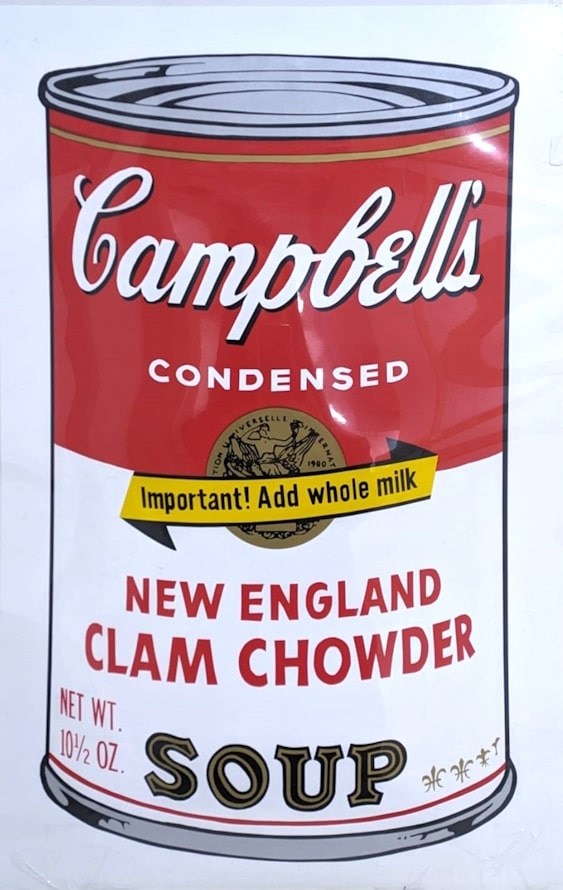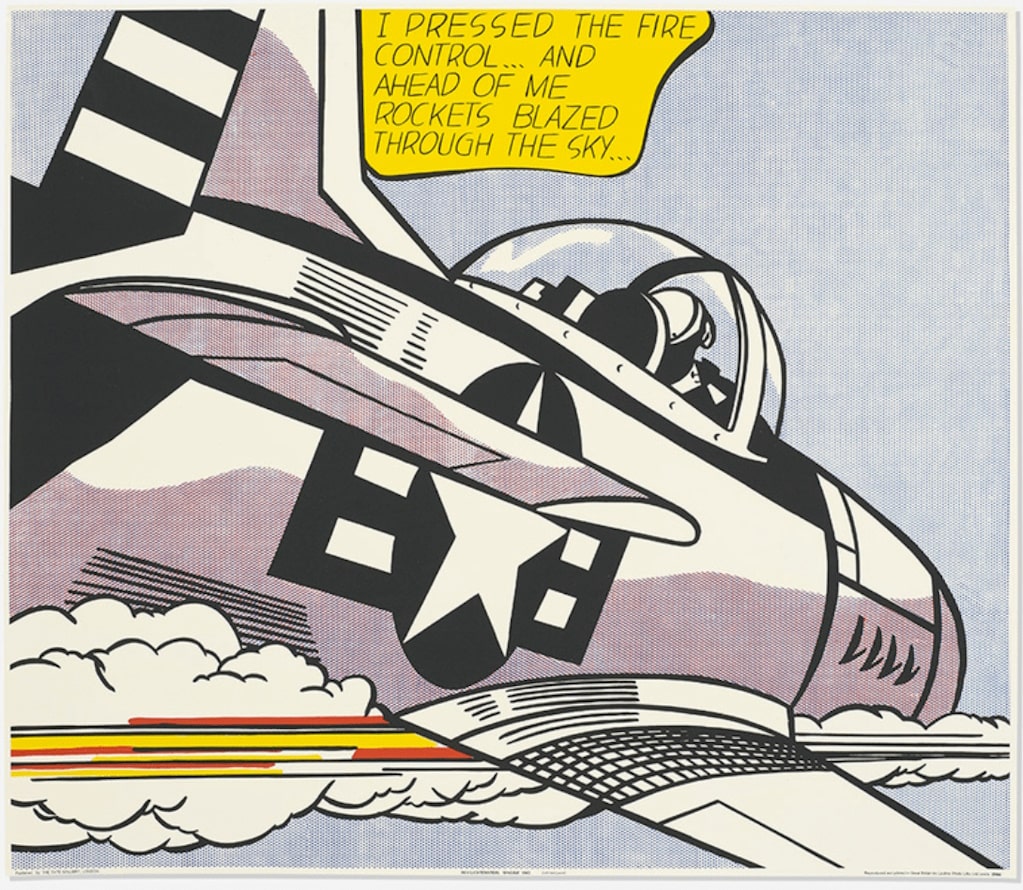With WHAAM! Action and consequences, CSR.ART Contemporary Show Room is presenting a group exhibition of pop art from Roy Lichtenstein and Andy Warhol to BANKSY and the present day for the finale of the year. WHAAM! opens on Wednesday, 13 December 2023 with a vernissage and Christmas Pop Party (the first 100 mulled wines are free) from 6 pm at CSR.ART, Friedrichstraße 69 in Berlin-Mitte.
Image above: Roy Lichtenstein, WHAAM!, 1963, Offset lithograph on paper (left panel from a diptych), 63 x 74 cm.
Pop art puts you in a good mood and celebrates life – in all its varieties from the banal to the transcendental. Pop Art ranges from Super Slick to Very Dirty, from Beautiful to Ugly, from Good to Bad. As Andy Warhol said: “If you want to know everything about Andy Warhol, just look at my surface, the surface of my paintings and films, and there I am. There’s nothing behind it.” The surface has all the information.

Nevertheless, pop art can be profound, even political. John Heartfield’s collages against the Nazis aimed for wide distribution and clear messages. That is why he marks the starting point of the show, as does Richard Hamilton, after whose work “Just what is it that makes today’s home so different, so appealing” Pop Art takes its name.
In 1970, Hamilton also briefly turned to agit prop: his work “Kent State” is agit prop at its finest. A photo of a student shot dead at Kent State University in an edition of 5000 was to hang in as many left-wing flats as possible around the world. The 8-colour screen printing pushed the print shop at the time to the limits of what was possible. 3000 copies were destroyed or damaged in a water leak. WHAAM! presents the almost flawless number 761 of the edition. Later, Joseph Beuys’ poster from 1979/80 helped the Greens and Klaus Staeck’s poster from 1990 helped the SPD in their election campaigns.

However, another branch of Pop Art also challenges our viewing habits and expands the definition of what is good taste and good art. In the “Bad but Good Art” section, Richard Lindner, Claes Oldenburg, Paul Wunderlich, Mark Kostabi (art critic Donald Kuspit wrote about him in Artforum: “His pictures are so bad that they even undermine the name of bad painting.”) and Milan Kunc (to whom his teacher Joseph Beuys once said: “Your art is so bad, it should be banned.”) push the pain threshold of our aesthetic sensibilities. Bernard Buffet was already labelled a kitsch artist in the 1950s. Today he is being rediscovered everywhere and is fetching high prices.

The clique of artists and gallery owners who long set the tone in post-war art in West Germany, propagating a mixture of minimalism, felt, fat, nails, blood and soil, successfully masked the fact for a long time that there was also a colourful and lively trend of intelligent Pop Art in Germany in the 1960s and 1970s. The names range from Werner Berges, Fritz Köthe and Werner Nöfer to Uwe Lausen, who as early as 1968 recreated Francis Bacon in psychedelic colours, and Sigmar Polke, whose works always carried a tongue-in-cheek humour, such as Polke’s original chimney sweep drawing. Katharina Sieverding also joins this series and enters into a surprising dialogue with two works by Hans Ticha, the only famous Pop Art artist from the former GDR who is only now being discovered by collectors.

In times of social change such as the early seventies (and today too?), art and big business converge: Gunter Fruhtrunk’s ALDI bag and Anton Stankowski’s logo for Deutsche Bank are key symbols of this and are therefore a must in the WHAAM! exhibition.

Pop art has always been outsider art, rebelling against the understanding of art in academia and the educated middle classes. It comes from the margins, from outside, often literally from the street. Banksy is the best-known example of an artist who has travelled the whole distance from agit prop street artist to auction favourite with six- to seven-figure prices and yet has remained true to himself (even if we still don’t know who is behind the street name). The street art section of the exhibition includes works by KAWS, Keith Haring, Banksy, H5N1 Death Squad, Shepard Fairy (known for his Obama poster “Hope”) and Thomas Baumgärtel, known as the banana sprayer of the art scene. André Boitard, who is omnipresent on the streets of Berlin and who has just done the anniversary cover of the 50th anniversary issue of Playboy, is also part of the exhibition, as is El Bocho, who is known from Friedrichshain pub facades.

Of course, the international elite of Pop Art is also extensively represented: From Mel Ramos to Takashi Murakami, from Damien Hirst to Roy Lichtenstein. And of course Andy Warhol (1928-1987). He revolutionised the art scene with his unique approach to art production and consumer culture. Warhol was a leading exponent of the Pop Art movement that emerged in the 1950s and 1960s. His artworks, including famous works such as the Campbell’s Soup Cans and the Marilyn Monroe series, reflect the mass production, advertising and consumer culture of his time. Warhol used innovative techniques such as screen printing to make art more accessible and reproducible. In addition to the obligatory Marilyns, the WHAAM! exhibits that you won’t find in any poster shop: An original silkscreen of the Marilyn motif, an original signed Brillo box and an original work by Horst Weber, who was Andy Warhol’s assistant for five years.
An equally important Pop artist was Roy Lichtenstein (1923-1997). He became known for his use of comic images and techniques in his paintings. Lichtenstein’s works, such as the diptych “Whaam!”, brought the visual language of comics to the high art scene. In autumn 1961, Lichtenstein presented these newly designed pictures to the New York gallery owner Leo Castelli. He immediately accepted them for his gallery. A few weeks later, Andy Warhol also showed up at the same gallery with comic pictures, but Castelli rejected them. When Andy Warhol saw Roy Lichtenstein’s pictures, he turned away from the subject of comics. He had recognised this niche as occupied and shifted to the artistic depiction of quantities and repetitions, with which he became world-famous.

Printed by Hadubrandt Michel, Düsseldorf, Germany, 83.4 x 83.4 cm, framed
To prevent the exhibition from becoming too museum-like, it builds bridges to Berlin street, club and pop art from the 90s to the present day. The works by Galya Feierman, DAG, Paul Waak, Betty Stürmer, Guthrie McDonald, Menno Aden, Undenk and Holm Friebe, from whose von Foerster collection many of the works in the Berlin Pop Art section come, enter into dialogue with the icons and repeatedly create surprising references.

BANKSY (1973 or 1974), although later than Warhol and Lichtenstein, exerts a considerable influence on the art scene today. Known for his politically committed street art works, “Banksy” remains anonymous and uses the street as a gallery for socially critical messages. His works are often provocative and provoke thought about social issues. In 2002, Banksy used stencils to create a black silhouette of a girl in east London, who lets a red, heart-shaped balloon fly away. The mural entitled “Balloon Girl” was cut out of the façade of a shop and realised £500,000 (around EUR 560,000) at auction in its framed state. In July 2017, the picture was voted the Brits’ favourite picture in a survey of 2,000 participants for Samsung TV. Banksy copied or varied his graffito “Girl with Balloon” from 2002 in various versions as a mural. The “Girl with Balloon” has become firmly anchored in the collective memory of the art world and retains a high recognition value even through various alterations.

The German Pop Art scene also had its representatives, although they may not have been as prominent as their American counterparts. Artists such as Sigmar Polke, Gerhard Richter and Konrad Lueg were part of the German Pop Art movement. Polke and Richter experimented with different techniques and styles, while Lueg was active not only as a painter but also as a gallery owner under his birth name Konrad Fischer. Konrad Lueg and Gerhard Richter organised the exhibition “Leben mit Pop – Eine Demonstration für den kapitalistischen Realismus” in 1963, which served as the starting point for the later use of the term “Capitalist Realism” by the art critic René Block.
Brand new are the works of Kennet Lekko, a new Berliner from Estonia like Mark Kostabi, whose ironic and sarcastic works are reminiscent of Keith Haring and Basquiat. Wolfgang Müller, Hoosen, Lukasz Furs, the recently deceased Pietro Sanguineti. Jurgen Ostarhild’s super-close portrait of Martin Kippenberger from the 90s corresponds with an original Kippenberger offset print from the 80s. And Charlie Stein, whose large format with the motif of a robot driving a racing car forms a central piece of the exhibition. Her fifty small-format Polaroids for 40 euros each are affordable for every visitor to the exhibition and once again emphasise the point that Pop Art in all its facets has always been profoundly democratic, even though it has long since arrived in the big museums.
Artists WHAAM! Action and Consequences
With among others Andy Warhol, Roy Lichtenstein, BANKSY, Keith Haring, KAWS, Sigmar Polke, Andy Denzler, Charlie Stein, Kennet Lekko, Toby Molitor, Uwe Lausen, Werner Berges, Bernard Buffet, Claes Oldenburg, Shepard Fairey, Takashi Murakami, Damien Hirst, Rudolf Hausner, Betty Stürmer, Xianwei Zhu and the SCUM manifesto of Valerie Solanas.
The exhibition WHAAM! Action and Consequences. is contrasted by the radical feminist position of the US feminist, author and activist Valerie Solanas, who died in 1988 and became known above all for her manifesto “SCUM (Society for Cutting Up Men)”. SCUM was published in 1967 by the publisher Maurice Girodias. The manifesto propagated the abolition of the male gender role and even envisaged the physical elimination of men. The positioning of Solanas’ SCUM manifesto in the WHAAM! exhibition reflects the actual controversy and the real influence of her actions. In June 1968, she attempted to assassinate the artist Andy Warhol in his studio. The reason is thought to be that Solanas felt rejected by Warhol and his Factory. She believed that Warhol should publish her screenplay and promote her artistic career. When Warhol refused, a sense of frustration and rejection may have developed that eventually led to her violent act. “It’s not often I shoot someone,” she said at the trial, “Read my manifesto, it explains who I am.” The inclusion of the SCUM manifesto in the Pop Art exhibition reflects the contemporary exploration of gender roles and patriarchal structures, and Pop Art itself tended to challenge social taboos and norms. In this context, the presentation of Solanas’ work is seen as an artistic expression of a rebellious attitude.
Text: Holm Friebe, Stephanie Schneider
WHEN?
Vernissage + Christmas Pop Party
Wednesday, 13.12.2023, 6 – 10 pm
The first 100 mulled wines are free.
Exhibition dates
Wednesday, 13.12.2023 until Wednesday, 10.01.2024
open Tue-Sat from 11:00 am to 7:00 pm
WHERE?
CSR.ART
Contemporary Show Room
Friedrichstraße 69
10117 Berlin-Mitte






